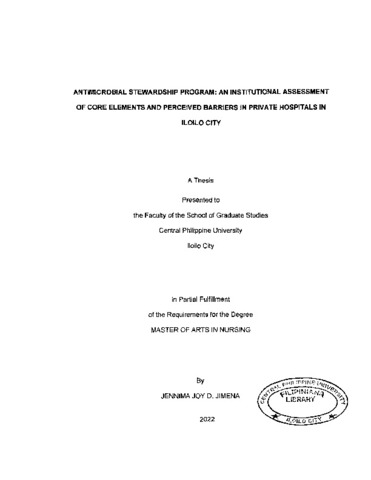Antimicrobial stewardship program: An institutional assessment of core elements and perceived barriers in private hospitals in Iloilo City
| dc.contributor.adviser | Abioda, Nenalyn D. | |
| dc.contributor.author | Jimena, Jennima Joy D. | |
| dc.coverage.spatial | Iloilo | en_US |
| dc.date.accessioned | 2023-03-07T03:22:34Z | |
| dc.date.available | 2023-03-07T03:22:34Z | |
| dc.date.issued | 2022 | |
| dc.identifier.citation | Jimena, J. J. D. (2022). Antimicrobial stewardship program: An institutional assessment of core elements and perceived barriers in private hospitals in Iloilo City (Unpublished Master's special paper). Central Philippine University, Jaro, Iloilo City. | en_US |
| dc.identifier.uri | https://hdl.handle.net/20.500.12852/2520 | |
| dc.description | Abstract only | en_US |
| dc.description.abstract | Infectious diseases kill millions of people around the globe and the discovery of antimicrobial agents revolutionizes the ability to treat infectious diseases. However, over the past years, the use and misuse of antimicrobials have caused emergence of antimicrobial-resistant (AMR) pathogens that threaten the effectiveness of antimicrobial agents in the cure of infectious diseases (File, 2014). To address the increasing concern on AMR, this study was conducted to have an in-depth picture of the Antimicrobial Stewardship (AMS) Program, including their perceived barriers, in the lens of healthcare professionals in participating private hospitals in Iloilo City. The study utilized the Case Study approach, which is a qualitative research, designed to explore and deepen the understanding on how people experience a certain topic (Creswell 2013). A purposive sampling technique was used to intentionally select a group of people that can provide in-depth information regarding the phenomenon of interest which is the AMS program. A total of seven (7) participants agreed to be interviewed for the study. Out of them, only three (3) participants agreed to be observed in their place of work. The participants consisted of Infection Control Nurses and Pharmacists. Data were collected using multiple sources of information which includes interviews, direct observations, and checklist review. Frequency Count, Percentage, and Mean were used to describe the quantitative data in the study, and Content Analysis was used to describe the qualitative data in the study. Findings of the study showed that healthcare professionals attending the AMS program are mostly young professionals. Pharmacists and infection control nurses involved in antimicrobial stewardship is not primarily dominated by one sex. Instead, there is an almost equal distribution between the sexes. Furthermore, most of the participants have more than a year of experience in their respective professions. Analyzing the quantitative data in a holistic perspective, AMS program implementation is very good in the education core element. Despite some hospitals lagging in the policy, guidelines and clinical aspect, the consolidated information showed that this is the second highest implemented core element. Third to fifth in the hierarchy is the leadership support, surveillance of AMU / AMR and action. Most of the participants verbalized lack of financial support, limited IT-capability and non-compliant healthcare professionals as barriers in the implementation of the AMS program. Narratives, direct observations and checklist review of both pharmacists and infection control nurses showed similarities in their perception of the AMS program. This implies that hospitals do not vary significantly in their perception, instead they do share the same experiences and challenges when implementing the program protocols. With this knowledge, we can already identify the issues that need to be addressed to strengthen and enhance an AMS program which will benefit and improve the healthcare system in our locality. | en_US |
| dc.format.extent | xi, 107 leaves | en_US |
| dc.language.iso | en | en_US |
| dc.subject.ddc | GSL Theses 610.73072 J564 | en_US |
| dc.subject.lcsh | Communicable diseases--Prevention | en_US |
| dc.subject.lcsh | Philippines--Iloilo | en_US |
| dc.subject.lcsh | Infection--Control | en_US |
| dc.subject.lcsh | Nurses | en_US |
| dc.subject.lcsh | Pharmacists | en_US |
| dc.title | Antimicrobial stewardship program: An institutional assessment of core elements and perceived barriers in private hospitals in Iloilo City | en_US |
| dc.type | Thesis | en_US |
| dcterms.accessRights | Not publicly accessible | en_US |
| dc.description.bibliographicalreferences | Includes bibliographical references | en_US |
| dc.contributor.chair | Alibogha, Salex E. | |
| dc.contributor.committeemember | Sale, Melba C. | |
| dc.contributor.committeemember | Baldon, Charlie D. | |
| dc.contributor.committeemember | Alba, Robyniel A. | |
| dc.contributor.committeemember | Canaman, Tony Ray A. | |
| dc.contributor.department | School of Graduate Studies | en_US |
| dc.description.degree | Master of Arts in Nursing | en_US |


